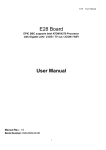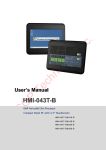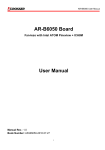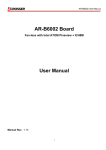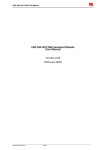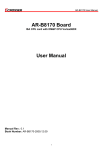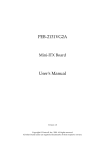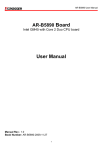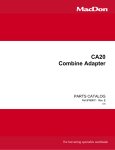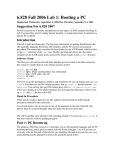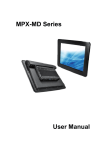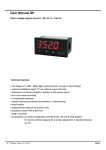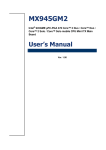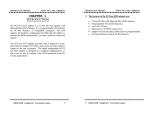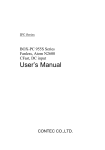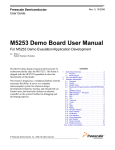Download AR-B5432 Board User Manual
Transcript
AR-B5432 Series User Manual AR-B5432 Board EPIC SBC supports Intel ATOM N270 Processor with Dual Gigabit LANs / LCD / TV out / DVI User Manual Manual Rev.: 1.0 Book Number: AR-B5432-2010.12.17 1 AR-B5432 Series User Manual Revision Version Date Author Description 1.0 2009.08.06 Roger Initial release. 1.01 2010.12.17 Roger Modified the manual descirption 2 AR-B5432 Series User Manual Copyright 2010 All Rights Reserved. Manual’s first edition: For the purpose of improving reliability, design and function, the information in this document is subject to change without prior notice and does not represent a commitment on the part of the manufacturer. In no event will the manufacturer be liable for direct, indirect, special, incidental, or consequential damages arising out of the use or inability to use the product or documentation, even if advised of the possibility of such damages. This document contains proprietary information protected by copyright. All rights are reserved. No part of this manual may be reproduced by any mechanical, electronic, or other means in any form without prior written permission of the manufacturer. Trademarks AR-B5432 is a registered trademarks of Acrosser; IBM PC is a registered trademark of the International Business Machines Corporation; Pentium is a registered trademark of Intel Technologies Inc; Award is a registered trademark of Award Software International Inc; other product names mentioned herein are used for identification purposes only and may be trademarks and/or registered trademarks of their respective companies. 3 AR-B5432 Series User Manual Table of Contents 1 Introduction ......................................................................................... 5 1.1 Specifications .....................................................................................................................6 1.2 Package Contents ..............................................................................................................7 1.3 Block Diagram ....................................................................................................................8 2 H/W Information .................................................................................. 9 2.1 Locations (Top Side) ..........................................................................................................9 2.2 Locations (Bottom Side)..................................................................................................10 2.3 Connector and Jumper Setting....................................................................................... 11 3 BIos Setting ....................................................................................... 15 3.1 Main Setup ........................................................................................................................16 3.2 Advanced Setup ...............................................................................................................17 3.3 Power Setup .....................................................................................................................18 3.4 PnP/PCI Setup ..................................................................................................................19 3.5 Peripherals Setup.............................................................................................................20 3.6 PC Health Setup ...............................................................................................................21 3.7 Boot Setup ........................................................................................................................22 3.8 Exit Setup..........................................................................................................................23 4 BIOS Refreshing, WatchDog and GPIO Programming .................. 25 4.1 BIOS Refreshing...............................................................................................................25 4.2 WatchDog Programming .................................................................................................26 4.3 GPIO Programming ..........................................................................................................30 5 Electrical Characteristics ................................................................. 35 5.1 Basic Electrical Characteristics Table............................................................................35 4 AR-B5432 Series User Manual 1 INTRODUCTION Welcome to the AR-B5432 Computer. The AR-B5432 is a Intel 945GSE chipset based platform designed for low power consumption and wide operating temperature. It supports the Atom N270 processor, while coming with a 533MHz Front Side Bus. 5 AR-B5432 Series User Manual 1.1 Specifications Processor: on-board Intel Atom N270 Single core and supports 2-Threads. 1.6GHz core frequency. 533MHz FSB. 512KBs L2 cache. 2.5W low TDP. Chipset-North Bridge: Intel 945GSE One SODIMM socket supports DDRⅡ 533/400 SODIMM and capacity up to 1GBs max. DVMT 3.0 supports 224MBs graphics memory max. (shared with system memory). Analog display supports 400MHz/256-bit RAMDAC, resolution QXGA (2048x1536@75Hz). 18-bits LVDS supports Single/Dual channel LCD, resolution UXGA (1600x1200). DVI-D supports 165MHz pixel rate max., resolution UXGA (1600x1200). Chipset-South Bridge: Intel 82801GM Two SATAⅡ connectors. AC’97 Codec ALC655 supports 5.1 CH. audio output. Two PCI-e GbE controllers - Intel 82574L - support 1000/100/10 Mbps LANs. Six USB2.0 ports. Supports +3.3V CompactFlash TypeⅡ card with Ultra-DMA mode 2/1/0. PCI-104 supports four PCI devices with PCI Bus Master mode. Super I/O: F81865F-I Internal WatchDog, programmable 1~255 second(s)/minute(s). 8 bits programmable bi-direction GPIOs, TTL-3.3V. Four serial ports, one supports RS232/485/422. One Serial Infrared (SIR), baud rate 115.2K bps max. (optional). Two DC fan connectors, one supports ON/OFF control by system temperature. Hardware monitor for voltage, fan speed and temperature. Others Power requirement: +12Vdc input only ([email protected] typically). Operating temperature: 0~60℃ (32~140℉). Storage temperature: -40~85℃ (-40~185℉). Relative humidity: 0~90%@40℃ (104℉), non-condensing. Dimension: 165 mm x 115 mm. 6 AR-B5432 Series User Manual 1.2 Package Contents Check if the following items are included in the package. AR-B5432 EPIC SBC board Quick Manual Software Utility CD 7 AR-B5432 Series User Manual 1.3 Block Diagram 8 AR-B5432 Series User Manual 2 H/W INFORMATION This chapter describes the installation of AR-B5432. First, it shows the function diagram and the layout of AR-B5432. Then describes the unpacking information which you should read carefully, as well as the jumper/switch settings for the AR-B5432 configuration. 2.1 Locations (Top Side) CN2 LVDS1 PWR2 JP2 CN7 PWR1 JP3 GPIO1 VGA1 PWR5 JP5 CN1 CN4 AUDIO1 LAN1 PWR3 SYSFAN1 LAN2 SATA1 COM1 CN3 SATA2 COM4 CN8 BAT1 COM3 LED1 IR1 COM2 CPUFAN1 CN6 DVI-D1 9 AR-B5432 Series User Manual 2.2 Locations (Bottom Side) SODIMM1 SKT1 CF1 10 AR-B5432 Series User Manual 2.3 Connector and Jumper Setting 1. CN2: PCI-104 connector. 3. JP3: Signal SERIRQ connects to PCI-104 pin #B1 selection. 2. JP2: CMOS data retention/clear. STATUS SETTING STATUS CMOS data retention. PCI-104 connector. 1-2 Disconnected. Open (Default). 2-3 4. PWR5: External +12V DC power input connector. SETTING (Default) CMOS data reset. 5. CN4: Internal USB2.0 connector for USB2.0 port #3, port #4. Short Connected. 6. PWR3: Extra +12V and +5V DC power output connector (for SATA device). PIN SETTING PIN SETTING PIN 1 2 3 4 SETTING 1 +5V 2 +5V 3 USB3- 4 USB4- 5 USB3+ 6 USB4+ 7 GND 8 GND 9 GND 10 GND GND GND +12V +12V 7. SATA1: SATA device connector #1. 8. SATA2: SATA device connector #2. SATA device SATA device connector #1. connector #2. 11 PIN SETTING 1 +12V 2 GND 3 +3.3V 4 +5V 9. BAT1: CMOS battery holder. CMOS battery holder. AR-B5432 Series User Manual 10. IR1: Infrared device connector. (Optional) 11. CN6: RS422/RS485 signal connector. PIN PIN 12. LVDS1: LCD panel (LVDS, 18-bit/36-bit) connector. SETTING SETTING PIN SETTING PIN SETTING 1 LCD VDD 2 GND 3 E CLK- 4 E CLK+ 5 GND 6 E Data2- 7 E Data2+ 8 GND 9 E Data1- 10 E Data1+ 11 NC 12 NC 13 E Data0+ 14 E Data0- 15 GND 16 O CLK+ 17 O CLK- 18 GND 19 O Data2+ 20 O Data2- 21 I2C CLK 22 O Data1+ 23 O Data1- 24 I2C Data 25 O Data0+ 26 O Data0- 27 NC 28 NC 29 LCD VDD 30 LCD VDD RS485 DATA+ 1 +3.3V 1 or RS422 TX+ 2 NC RS485 DATA- 3 2 IR RX or RS422 TX4 5 GND RS422 RX+ 4 RS422 RX- IR TX 13. CN7: Front panel connector. (NOTE 1) STATUS 3 14. GPIO1: 8-bit TTL-3.3V GPIO connector. SETTING External buzzer. PIN SETTING PIN SETTING 1 1: Buzz + 2 1 +3.3V 2 GND 3 GPIO [50] 4 GPIO [54] 5 GPIO [51] 6 GPIO [55] 7 GPIO [52] 8 GPIO [56] 9 GPIO [53] 10 GPIO [57] 2: Buzz 3-4 Hardware reset Power button for ATX mode; 5-6 jumper opened E: Even for dual channel. O: Odd for single channel. for AT mode. 15. JP5: COM2 function RS232/RS422/RS485 selection. STATUS 16. AUDIO1: 5.1 channels Audio signal connector. 17. SYSFAN1: System DC fan connector. SETTING PIN SETTING PIN SETTING PIN SETTING 1 GND 2 +12V 3 Fan speed data COM2 as 1 Line-out Right 2 Line-out Left 1-2 RS232. 3 AGND 4 AGND (Default) 5 Line-in Right 6 Line-in Left COM2 as 7 MIC-in 8 AGND RS422. 9 AGND 10 AGND 3-4 COM2 as 5-6 11 SR-out Right 12 SR-out Left 13 LFT-out RS485. 12 14 SEN-out ON/OFF controlled by system temperature setting of BIOS. AR-B5432 Series User Manual 18. COM1: D-SUB-9 male connector for RS232 port #1. 19. COM4: RS232 signal connector for port #4. 20. COM3: RS232 signal connector for port #3. PIN SETTING PIN SETTING PIN SETTING PIN SETTING 1 DCD #4 2 DSR #4 1 DCD #3 2 DSR #3 D-SUB-9 male connector 3 RX #4 4 RTS #4 3 RX #3 4 RTS #3 for RS232 port #1. 5 TX #4 6 CTS #4 5 TX #3 6 CTS #3 7 DTR #4 8 RI #4 7 DTR #3 8 RI #3 9 GND 10 NC 9 GND 10 NC 21. COM2: RS232 signal connector for port #2. 22. DVI-D1: DVI-D signal output connector. PIN SETTING PIN SETTING 23. PWR2: LCD panel driving voltage selection. PIN SETTING PIN SETTING 1 GND 2 Data 0+ 3 Data 0- 4 GND 5 Data 1+ 6 Data 1- 7 GND 8 Data 2+ 1 DCD #2 2 DSR #2 9 Data 2- 10 GND 3 RX #2 4 RTS #2 11 CLK + 12 CLK - STATUS SETTING +3.3V for LCD panel. 1-2 5 TX #2 6 CTS #2 13 DPD 14 I2C CLK 7 DTR #2 8 RI #2 15 +5V 16 I2C Data 9 GND 10 NC 17 NC 18 GND 19 NC 20 GND 21 NC 22 GND 23 NC 24 NC 25 NC 26 NC 24. PWR1: LCD panel inverter power connector. 25. VGA1: D-SUB-15 female connector for VGA output. (Default). +5V for LCD panel. 2-3 26. CN1: TV-out signal connector. PIN SETTING PIN SETTING 1 +12V 1 Luminance. 2 Reserved. 2 +12V PIN SETTING 3 GND 4 Reserved. D-SUB-15 female 5 NC 6 NC connector for VGA output. 7 GND 8 Reserved. 3 GND 4 BKL ON 5 GND 11 GND 12 NC 6 Reserved. 13 NC 14 NC 9 13 Chrominance. 10 GND AR-B5432 Series User Manual 27. LAN1: RJ45 connector for Gigabit Ethernet port #1. 28. LAN2: RJ45 connector for Gigabit Ethernet port #2. RJ45 connector for Gigabit RJ45 connector for Ethernet port #1. Gigabit Ethernet Wake-On-LAN supported. port #2. 30. CN8: USB A-type stack connector for USB2.0 port #5, port #6. 31. LED1: System standby power and HDD access indicators. 29. CN3: USB A-type stack connector for USB2.0 port #1, port #2. Upper: Port #2. Lower: Port #1. 32. CPUFAN1: CPU DC fan connector. Green: Standby PIN SETTING Upper: Port #6. power indicator. 1 GND Lower: Port #5. Yellow: HDD access 2 +12V indicator. 3 Fan speed data 33. SODIMM1: 200-pin un-buffered DDRⅡ SODIMM socket. 34. SKT1: 32-PLCC socket for flash EEPROM (system BIOS access). 35. CF1: TypeⅡ compact flash card socket. Supports DDRⅡ 533/400MHz un-buffered 32-PLCC socket for +3.3V CF card only and and non-ECC SODIMM. flash EEPROM. UDMA mode supported. Capacity is 2GBs max. 14 AR-B5432 Series User Manual 3 BIOS SETTING This chapter describes the BIOS menu displays and explains how to perform common tasks needed to get the system up and running. It also gives detailed explanation of the elements found in each of the BIOS menu displays. The following topics are covered: Main Setup Advanced Setup Power Setup PnP/PCI Setup Peripherals Setup PC Health Setup Boot Setup Exit Setup Once you enter the BIOS CMOS setup utility, you can use the control keys that listed at the bottom of the menu to select the desired value in each item. 15 AR-B5432 Series User Manual 3.1 Main Setup Option Choice Description Date Setup N/A To set the system date. Note that the ‘Day’ automatically changes when you set the date. Time Setup N/A To set the system time. IDE Channel 0 Master/Slave IDE Channel 2 Master/Slave N/A Press <Enter> to view the IDE device’s information and related parameters. Halt On All Errors, No Errors, All, But keyboard. To select the situation in which you want the BIOS to stop the POST process and notify you. 16 AR-B5432 Series User Manual 3.2 Advanced Setup Option Choice Description Quick Power On Self Test Enabled Disabled This category speeds up Power On Self Test (POST) after you have powered up the computer. If it is set to Enabled, BIOS will shorten or skip some check items during POST. Full Screen Logo Show Enabled Disabled Select Enabled to show the OEM full screen logo if you have add-in BIOS. Boot Display CRT LVDS CRT+LVDS To set the display device. DVI TV CRT+DVI Panel Type 800x600 1024x768 DVMT mode FIXED DVMT Both To set the LVDS panel resolution that you want. To set the mode of Dynamic Video Memory Technology (DVMT). 17 AR-B5432 Series User Manual DVMT/FIXED Memory Size 64MB 128MB 224MB To set the shared memory size for DVMT. 3.3 Power Setup 18 AR-B5432 Series User Manual 3.4 PnP/PCI Setup Option Reset Configuration Data Resources Controlled By IRQ Resources Choice Description Enabled Disabled Normally, you leave this field Disabled. Select Enabled to reset Extended System Configuration Data (ESCD) when you exit setup. If you have installed a new add-on and the system reconfiguration has caused such a serious conflict, then the operating system can not boot. The Award Plug and Play BIOS has the capacity to automatically configure all of the boot and Plug and Play compatible devices. However, this capability means Auto(ESCD) absolutely nothing unless you are using a Plug and Play Manual operating system such as Windows 95. If you set this field to “manual,” then you may choose specific resources by going into each of the submenus. N/A When resources are controlled manually, assign a type to each system interrupt,depending on the type of the device that uses the interrupt. 19 AR-B5432 Series User Manual 3.5 Peripherals Setup Option Choice Description Onboard Serial Port 1 Serial Port 1: 3F8 / IRQ4 Onboard Serial Port 2 Serial Port 2: 2F8 / IRQ3 Select an address and the corresponding Onboard Serial Port 3 Serial Port 3: 3E8 / IRQ11 interrupt for each serial port. Onboard Serial Port 4 Serial Port 4: 2E8 / IRQ10 AC97 Auido Select Enabled Disabled This item allows you to enable/disable AC97 Audio. USB Device setting Press Enter Press <Enter> to Enabled/Disabled USB controllers and view device’s information. OnChip IDE Device N/A Press <Enter> to Enabled/Disabled IDE/SATA controllers or set parameters. 20 decide to AR-B5432 Series User Manual 3.6 PC Health Setup 21 AR-B5432 Series User Manual 3.7 Boot Setup Option Choice Description First / Second / Third Boot Device/Other Boot Device Hard Disk CDROM USB-FDD USB-CDROM LAN Disabled The BIOS attempts to load the operating system from the devices in the sequence selected in these items. Lan Boot Select Disabled Lan-1 Lan-2 These fields allow the system to search for an OS from LAN. Hard Disk Boot Priority N/A Press <Enter> to set the boot priority for each bootable device. 22 AR-B5432 Series User Manual 3.8 Exit Setup Option Choice Description Save & Exit Setup Press “Y” to store the selections made in the menus in CMOS – a special section of Pressing <Enter> on this memory that stays on after you turn your item for confirmation: system off. The next time you boot your computer, the BIOS configures your system Save to CMOS and EXIT according to the Setup selections stored in (Y/N)? Y CMOS. After saving the values the system is restarted again. Load Optimized Defaults When you press <Enter> on this item you get a confirmation dialog box Press ‘Y’ to load the default values that are with a message like this: factory-set for optimal-performance system operations. Load Optimized Defaults (Y/N)? N 23 AR-B5432 Series User Manual Pressing <Enter> on this This allows you to exit Setup without storing item for confirmation: any changes in CMOS. The previous Exit Without Saving selections remain in effect. This shall exit the Quit without saving (Y/N)? Setup utility and restart your computer. Y When a password has been enabled, you will be prompted to enter your password every time you try to enter setup. This prevents unauthorized persons from changing any part of your system configuration. Set Password Type the password, up to eight characters in length, and press <Enter>. The password typed now will clear any previous password Pressing <Enter> on this from the CMOS memory. You will be asked to item for confirmation: confirm the password. Type the password again and press <Enter>. You may also press ENTER PASSWORD: <Esc> to abort the selection and not enter a password. To disable a password, just press <Enter> when you are prompted to enter the password. A message will confirm that the password will be disabled. Once the password is disabled, the system will boot and you can enter Setup freely. 24 AR-B5432 Series User Manual 4 BIOS REFRESHING, WATCHDOG AND GPIO PROGRAMMING 4.1 BIOS Refreshing The BIOS program instructions are contained within computer chips called FLASH ROMs that are located on your system board. The chips can be electronically reprogrammed, allowing you to update your BIOS firmware without removing and installing chips. The AR-B5432 provides the FLASH BIOS update function for you to easily to update BIOS. Please follow these operating steps to update BIOS: Step 1: You must boot up system into MS-DOS first and please don’t detect files CONFIG.SYS and AUTOEXEC.BAT. Step 2: In the MS-DOS mode, you should execute the AWDFLASH program to update BIOS. Step 3: Follow all messages then you could update BIOS smoothly. 25 AR-B5432 Series User Manual 4.2 WatchDog Programming This section describes the usage of WatchDog. AR-B5432 integrated the WatchDog that enable user to reset the system after a time-out event. User can use a program to enable the WatchDog and program the timer in range of 1~255 second(s)/minute(s). Once user enables the WatchDog, the timer will start to count down to zero except trigger the timer by user’s program continuously. After zeroize the timer (stop triggering), the WatchDog will generate a signal to reset the system. It can be used to prevent system crash or hang up. The WatchDog is disabled after reset and should be enabled by user’s program. Please refer to the following table to program WatchDog properly, and user could test WatchDog under ‘Debug’ program. Address port: 2E and Data port: 2F C:>debug To enter debug mode. -o 2E 87 To enter configuration. -o 2E 87 -o 2E 07 To point to Logical Device Number Reg. -o 2F 07 To select logical device 7 (WatchDog) -o 2E 30 To activate WatchDog. -o 2F 01 -o 2E F5 Preparing to select the unit of timer equals minute or second. -I 2F To read the value of index “2F”. The value “xx” equals [(value of index “2F”) OR (F7) or (FF)]. -o 2F xx OR (F7): unit is second. OR (FF): unit is minute. -o 2E F6 Preparing to set the WatchDog timer value. -o 2F ## The value “##” ranges between 01 ~ FF (1 ~ 255). 00: To disable WatchDog. -o 2E FA Preparing to set the WatchDog output signal. -I 2F To read the value of index “2F”. -o 2F xx The value “xx” equals [(value of index “2F”) OR (01)]. To issue signal WDTRST to reset system. -o 2E F5 Preparing to start the WatchDog timer counting. -I 2F To read the value of index “2F”. -o 2F xx The value “xx” equals [(value of index “2F”) OR (20)]. To start timer counting. -q To quit debug mode 26 AR-B5432 Series User Manual WatchDog demo program in Turbo C++ as following: //=========================================================================== // Turbo C++ Version 3.0 Copyright(c) 1990, 1992 by Borland International,Inc. //=========================================================================== // Describe : F81865 WatchDog timer test //=========================================================================== //=========================================================================== // Language include files //=========================================================================== #include <conio.h> #include <stdlib.h> #include <stdio.h> #include <dos.h> //=========================================================================== // Normal procedure //=========================================================================== void Show_Help(); //=========================================================================== // Main procedure //=========================================================================== int main(int argc, char *argv[]) { unsigned char IO_Port_Address=0x2E; unsigned char Time; int Temp; if ( argc != 2 ) { Show_Help(); return 1; } clrscr(); Time=atoi(argv[1]); // Set Watchdog 27 AR-B5432 Series User Manual outportb(IO_Port_Address,0x87); // Enter Configuration outportb(IO_Port_Address,0x87); outportb(IO_Port_Address,0x07); // Point to Logical Device Number Reg. outportb(IO_Port_Address+1,0x07); // Select logical device 7, (Watchdog Function) outportb(IO_Port_Address,0x30); // Device Active register outportb(IO_Port_Address+1,0x01); outportb(IO_Port_Address,0xF5); // Select Watchdog count mode seconds or minutes outportb(IO_Port_Address+1,inportb(IO_Port_Address+1)&0xF7); outportb(IO_Port_Address,0xF5); // Select Watchdog output mode outportb(IO_Port_Address+1,inportb(IO_Port_Address+1)|0x10); outportb(IO_Port_Address,0xF6); // Default is second, bit3=0 // Set to Pulse mode, bit4=1 // Set Watchdog Timer Value outportb(IO_Port_Address+1,Time); // 0x00 to disable, max 0xFF outportb(IO_Port_Address,0xFA); // Set Watchdog Time out output via WDTRST outportb(IO_Port_Address+1,inportb(IO_Port_Address+1)|0x01); // bit0=1 outportb(IO_Port_Address,0xF5); // Start Watchdog Time counting outportb(IO_Port_Address+1,inportb(IO_Port_Address+1)|0x20); // bit5=1 textcolor(YELLOW); for(Temp=Time;Temp>0;Temp--) { outportb(IO_Port_Address,0xF6); // Read Watchdog Timer Value Time=inportb(IO_Port_Address+1); gotoxy(20,10); cprintf(">>> After %3d Second will reset the system. <<<",Time); delay(1000); } textcolor(LIGHTRED); gotoxy(18,10); 28 AR-B5432 Series User Manual cprintf("If you can see this message, Reset system is Fail",Time); return 1; } //=========================================================================== // Function : Show_Help() // Input :- // Change : // Return : // Description : Show Title string. //=========================================================================== void Show_Help() { clrscr(); printf("WatchDog Test for F81865 \n\n"); printf("Sample: \n"); printf(" WDT.EXE 10 \n"); printf("( For 10 seconds to reset. )\n"); } 29 AR-B5432 Series User Manual 4.3 GPIO Programming This section describes the usage of GPIOs. AR-B5432 integrated eight bits, TTL-3.3V, bidirectional, and software programmable GPIOs for user’s application. Address port: 2E and Data port: 2F GP## GP57 GP56 GP55 GP54 GP53 GP52 GP51 GP50 Bit 7 (MSB) Bit 6 Bit 5 Bit 4 Bit 3 Bit 2 Bit 1 Bit 0 (LSB) Bit # GPIO demo program in Turbo C++ as following: //=========================================================================== // Turbo C++ Version 3.0 Copyright(c) 1990, 1992 by Borland International,Inc. //=========================================================================== // Describe : GPIO50~GPIO57 Test utility for F81865. //=========================================================================== //=========================================================================== // Language include files //=========================================================================== #include <conio.h> #include <stdio.h> //=========================================================================== // Normal procedure //=========================================================================== void Show_Help(); void Show_Fail(); void Show_Pass(); //=========================================================================== // Main procedure //=========================================================================== int main(int argc) { 30 AR-B5432 Series User Manual char *Model_Name="AR-B5432"; unsigned char IO_PORT_BASE=0x2E; // DATA_PORT = IO_PORT_BASE + 1; unsigned char data; int result=0; if ( argc > 1 ) { Show_Help(); return 1; } clrscr(); textcolor(WHITE); gotoxy(1, 1); cprintf("<>==========================================================================<>"); gotoxy(1, 2); cprintf("|| F81865 GPIO Test Utility v1.0 Acrosser Technology Co., Ltd. ||"); gotoxy(1, 3); cprintf("<>==========================================================================<>"); gotoxy(1, 4); cprintf("<>==========================================================================<>"); gotoxy(1, 5); cprintf("|| Model Name : ||"); gotoxy(1, 6); cprintf("|| SIO IO Base : ||"); gotoxy(1, 7); cprintf("<>==========================================================================<>"); // Show Got Parameter Informat textcolor(LIGHTGRAY); gotoxy(18,5); cprintf("%s",Model_Name); gotoxy(18,6); cprintf("%X",IO_PORT_BASE); // Enter F81865 Config outportb(IO_PORT_BASE,0x87); outportb(IO_PORT_BASE,0x87); // Set Multi-function Pins to GPIO outportb(IO_PORT_BASE,0x2A); outportb(IO_PORT_BASE+1,(inportb(IO_PORT_BASE+1) | 0x08)); // Select GPIO Port device outportb(IO_PORT_BASE,0x07); outportb(IO_PORT_BASE+1,0x06); 31 AR-B5432 Series User Manual // Set GPIO Port Active outportb(IO_PORT_BASE,0x30); outportb(IO_PORT_BASE+1,0x01); // Set F81865 GPIO50~53 to Output, GPIO54~GPIO57 to Input outportb(IO_PORT_BASE,0xA0); outportb(IO_PORT_BASE+1,0x0F); // Set F81865 GPIO50~53 to High outportb(IO_PORT_BASE,0xA1); outportb(IO_PORT_BASE+1,0x0F); // Read F81865 GPIO54~57 Status, if not High error. outportb(IO_PORT_BASE,0xA2); data=inportb(IO_PORT_BASE+1)&0xF0; if(data!=0xF0) result=1; // Set F81865 GPIO50~53 to Low outportb(IO_PORT_BASE,0xA1); outportb(IO_PORT_BASE+1,0x00); // Read F81865 GPIO54~57 Status, if not Low error. outportb(IO_PORT_BASE,0xA2); data=inportb(IO_PORT_BASE+1)&0xF0; if(data!=0x00) result=1; // Set F81865 GPIO50~53 to input, GPIO54~GPIO57 to Output outportb(IO_PORT_BASE,0xA0); outportb(IO_PORT_BASE+1,0xF0); // Set F81865 GPIO54~57 to High outportb(IO_PORT_BASE,0xA1); outportb(IO_PORT_BASE+1,0xF0); // Read F81865 GPIO50~53 Status, if not High error. outportb(IO_PORT_BASE,0xA2); data=inportb(IO_PORT_BASE+1)&0x0F; if(data!=0x0F) result=1; 32 AR-B5432 Series User Manual // Set F81865 GPIO54~57 to Low outportb(IO_PORT_BASE,0xA1); outportb(IO_PORT_BASE+1,0x00); // Read F81865 GPIO50~53 Status, if not Low error. outportb(IO_PORT_BASE,0xA2); data=inportb(IO_PORT_BASE+1)&0x0F; if(data!=0x00) result=1; // Exit F81865 Config outportb(IO_PORT_BASE,0xAA); if(result) Show_Fail(); else Show_Pass(); return result; } //=========================================================================== // Function : Show_Help() // Input :- // Change : // Return : // Description : Show Title string. //=========================================================================== void Show_Help() { clrscr(); printf("GPIO Test utility for F81865\n\n"); printf("VCC GND \n"); printf("GPIO50 迋迋迋迋 GPIO54\n"); printf("GPIO51 迋迋迋迋 GPIO55\n"); printf("GPIO52 迋迋迋迋 GPIO56\n"); printf("GPIO53 迋迋迋迋 GPIO57\n"); } 33 AR-B5432 Series User Manual //=========================================================================== // Function : Show_Fail() // Input :- // Change : // Return : // Description : Show Fail Message. //=========================================================================== void Show_Fail() { textcolor(LIGHTRED); gotoxy(20,10); cprintf(" 詗詗詗詗 詗詗詗 gotoxy(20,11); cprintf(" 詗 gotoxy(20,12); cprintf(" 詗詗詗? 詗詗詗詗 gotoxy(20,13); cprintf(" 詗 詗 詗 詗 gotoxy(20,14); cprintf(" 詗 詗 詗 詗詗 詗 詗 詗詗 詗 "); 詗 詗 "); 詗 詗 詗 "); "); 詗詗詗詗"); } //=========================================================================== // Function : Show_Pass() // Input :- // Change : // Return : // Description : Show Pass Message. //=========================================================================== void Show_Pass() { textcolor(LIGHTGREEN); gotoxy(20,10); cprintf(" 詗詗詗詗 詗詗詗 詗詗詗詗 詗詗詗詗"); gotoxy(20,11); cprintf(" 詗 gotoxy(20,12); cprintf(" 詗詗詗詗 詗詗詗詗 詗詗詗詗 詗詗詗詗"); gotoxy(20,13); cprintf(" 詗 詗 詗 gotoxy(20,14); cprintf(" 詗 詗 詗 詗詗詗詗 詗詗詗詗"); 詗 詗 詗 詗 詗 詗 } 34 "); 詗"); AR-B5432 Series User Manual 5 ELECTRICAL CHARACTERISTICS 5.1 Basic Electrical Characteristics Table Electrical Characteristics Value Parameter / Condition Unit Min. Typ. Max. 11.4 12.0 12.6 V +12V External power input for system or +12Vdc power output (for SATA, LCD inverter, … etc.) +5V +5Vdc power output (for SATA, USB, DVI, … etc.) 4.75 5.0 5.25 V +3.3V +3.3Vdc power output (for LVDS, PCI-104, … etc.) 3.14 3.30 3.46 V GPIO VIL GPIO’s maximum Input LOW voltage - - 0.8 V GPIO VIH GPIO’s minimum input HIGH voltage 2.0 - - V GPIO VOL GPIO’s typical output LOW voltage - 0 - V GPIO VOH GPIO’s typical output HIGH voltage - 3.3 - V 35




































